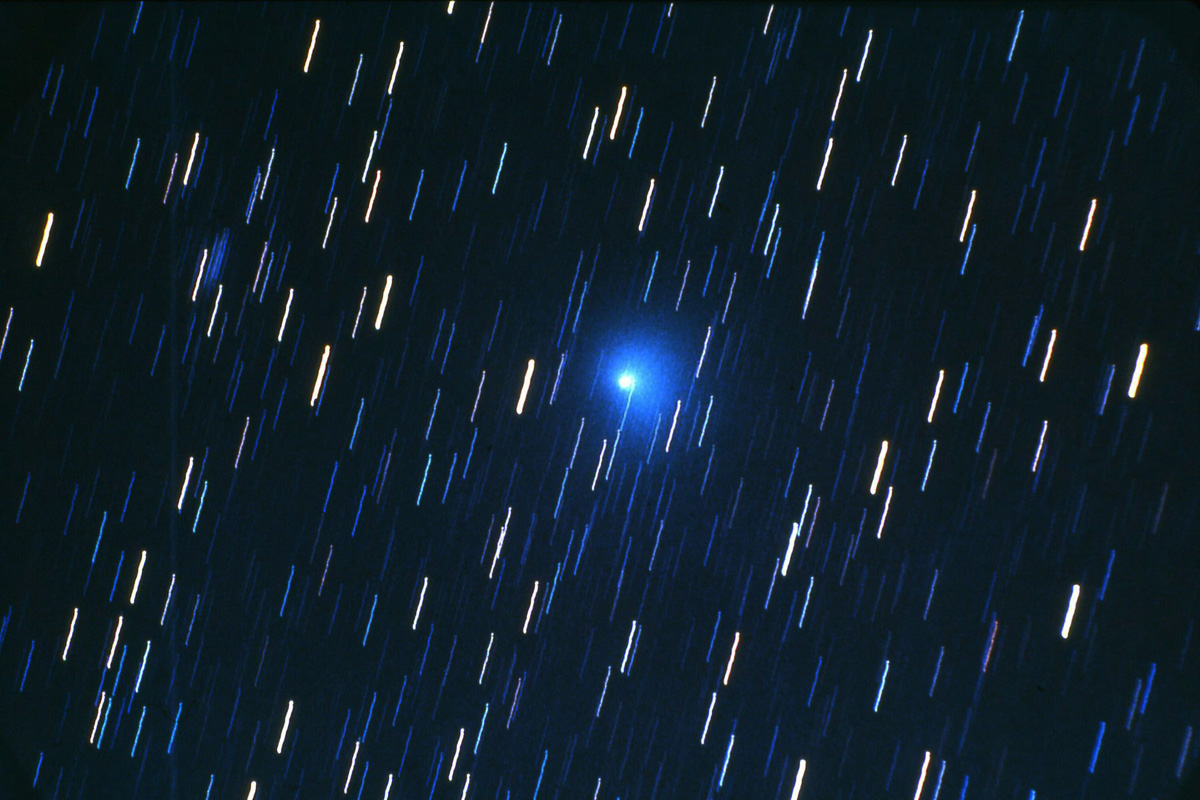

COMET OF THE WEEK
WEEK 20: MAY 10-16
COMET IRAS-ARAKI-ALCOCK 1983d
Perihelion: 1983 May 21.25, q = 0.991 AU
On April 25 – three months after its launch – the infrared sensors aboard IRAS detected a “fast-moving object.” Due to some breakdowns in communication and some initial uncertainty as to just what this object was, it wasn’t until early May that astronomers finally determined that the new IRAS object was a previously-unknown comet. By that time the comet had been independently discovered on May 3 by two amateur astronomers: Genichi Araki in Japan and George Alcock in England. (Alcock was a very well-known amateur astronomer who had discovered four comets from the late 1950s through mid-1960s as well as several novae after that, and at the time of his discovery of this comet was searching for novae with binoculars from indoors through a closed window!) Visual observations at the time indicated that the comet was as bright as 6th magnitude and exhibited a large coma 15 to 20 arcminutes in diameter.
Orbital calculations soon indicated that Comet IRAS-Araki-Alcock was rapidly approaching Earth, and would pass just 0.031 AU from Earth on May 11 – the closest confirmed cometary approach to Earth in over two centuries. It brightened rapidly as it approached Earth, and a couple of days before its closest approach it was as bright as 3rd magnitude with a coma approximately one degree in diameter; it never exhibited much in the way of a tail.
On the night of closest approach, May 10-11, the comet was as bright as 2nd magnitude with a coma between 2 and 3 degrees across. At the beginning of the night it was located a few degrees west of the “bowl” of the Big Dipper, and was moving towards the southwest at two degrees per hour. To the unaided eye it appeared as a diffuse cloud, but telescopically it exhibited a number of fanlike features, streamers, and pillar-like structures throughout the inner coma. The sight of the comet’s central condensation traveling against the background stars in “real time” remains among the most dramatic sights I have seen in all my years of comet observing.

 LEFT: Comet IRAS-Araki-Alcock on May 11, 1983, during the time of its closest approach to Earth. Photograph courtesy Alan Gorski. RIGHT: Infrared image of Comet IRAS-Araki-Alcock obtained by the IRAS spacecraft. Courtesy NASA/IPAC.
LEFT: Comet IRAS-Araki-Alcock on May 11, 1983, during the time of its closest approach to Earth. Photograph courtesy Alan Gorski. RIGHT: Infrared image of Comet IRAS-Araki-Alcock obtained by the IRAS spacecraft. Courtesy NASA/IPAC.
During its passage by Earth the Arecibo radio telescope in Puerto Rico and the Deep Space Network’s tracking antenna in Goldstone, California both successfully detected the comet’s nucleus via radar – the first radar detections of a long-period comet -- with the data indicating that the nucleus is a non-spherical object some five to eight km in diameter, and accompanied by a dense swarm of “particles” (centimeter-sized and larger) out to a distance of approximately 800 km or more. The International Ultraviolet Explorer (IUE) satellite detected the presence of diatomic sulfur (S2) in the inner coma; since this molecule can only be formed and maintained in very cold conditions, this tells us much about the environments within which comets are formed.
Following its passage by Earth Comet IRAS-Araki-Alcock rapidly headed southward and within a couple of days was accessible only from the southern hemisphere. After maintaining its brightness for another day or so it faded rapidly, dropping below naked-eye visibility during the third week of May and to 7th magnitude by the end of the month. It was followed visually until mid-July, and the final observations were obtained in early October.
Comet IRAS-Araki-Alcock’s approach to Earth was the closest confirmed cometary approach during the entire 20th Century, and at this writing is the fifth-closest confirmed approach in all of recorded history. Close cometary approaches to Earth, both past and future, are discussed in this week’s “Special Topics” presentation.
By a most remarkable coincidence, the comet that accounted for the 20th Century’s fourth-closest confirmed approach to Earth was discovered while all the excitement was taking place with Comet IRAS-Araki-Alcock. Comet Sugano-Saigusa-Fujikawa 1983e was independently discovered by three Japanese amateur astronomers on May 8, having already passed through perihelion on May 1 at a heliocentric distance of 0.471 AU. This newer comet was apparently much smaller than its predecessor, with radar bounce observations indicating that its nucleus was no more than a few hundred meters in diameter, and while it did reach 6th magnitude at the time of its closest approach of 0.063 AU on June 12 it appeared as little more than a vague diffuse cloud one degree in diameter. It faded rapidly after that and disappeared from view within a week.
“Comet of the Week” archive
Ice and Stone 2020 home page
Earthrise Institute home page